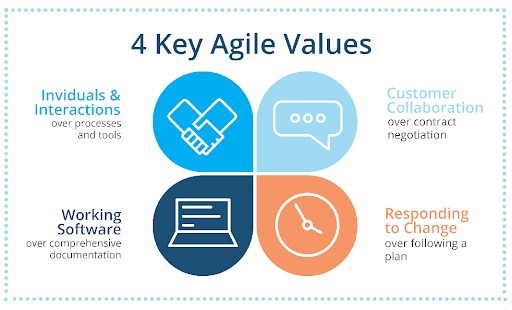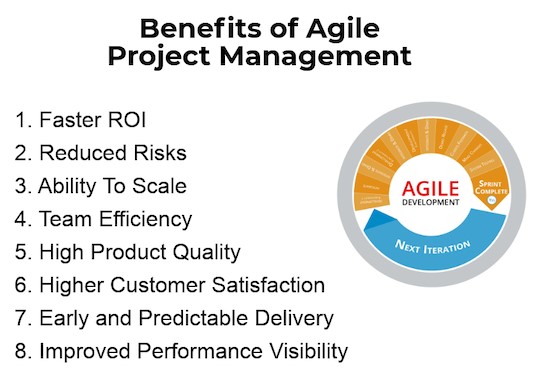Table of Contents
ToggleIn today’s highly projected global economy, Agile stands out as a beacon for those seeking flexibility, efficiency, and collaboration. Originating in the software development industry, Agile methodologies have transcended boundaries, offering a robust framework for managing a wide array of projects. This guide delves into the basics of Agile project management, elucidating its principles, practices, and profound benefits for newcomers.

Understanding Agile Project Management
Agile project management is an iterative approach to delivering a project throughout its life cycle. Iterative or agile life cycles are composed of several iterations or incremental steps towards the completion of a project. Irrespective of the complexity of a project, Agile practices are more open to ever-changing requirements in today’s dynamic business landscape and encourage constant feedback from the end users than standard waterfall project management methods. Its essence lies in its core values and principles articulated in the Agile Manifesto, a seminal document that has guided countless teams to achieve efficiency and excellence.
The Core Values of Agile
At its heart, Agile project management is built upon four foundational values:
- Individuals and interactions over processes and tools: Agile prioritizes human communication and collaboration, even over the most sophisticated tools and processes. This value underscores the importance of a motivated, empowered team.
- Working software over comprehensive documentation: Documentation has its place in understanding the initial requirements, Agile methodologies emphasize the primary goal of delivering functional, valuable software to customers promptly.

Source: Geneca
- Customer collaboration over contract negotiation: Agile champions ongoing collaboration with customers, ensuring the delivered product meets their needs and expectations, rather than strictly adhering to contractual terms.
- Responding to change over following a plan: In an Agile project, flexibility is paramount. The ability to adapt to changes—even late in the development process—is seen as a strength rather than a disruption.
Principles Behind the Agile Manifesto
Agile is further defined by twelve principles that guide the execution of its methodologies, including:
- The highest priority is to satisfy the customer through early and continuous delivery of valuable software.
- Welcome changing requirements, even late in development.
- Deliver working software frequently, with a preference for shorter timescales.
- Business people and developers must work together daily throughout the project.
- Build projects around motivated individuals. Give them the environment and support they need, and trust them to get the job done.
- These principles foster an environment of flexibility, collaboration, and efficiency, hallmarks of the Agile approach.
Read in-depth: Agile Manifesto
Popular Agile Methodologies
Several methodologies fall under the Agile umbrella, each with its unique approach and focus areas. The most prominent include:
- Scrum: Scrum is a popular Agile framework that is used to prioritize work based on the business value in a time-boxed fashion. It uses fixed-length iterations, called sprints, typically two weeks or a month-long, with a daily stand-up meeting to discuss tasks and roadblocks.
- Kanban: Kanban is a visual approach to managing tasks and workflows, which helps teams visualize their work, limit work-in-progress, and maximize efficiency (or flow).
- Lean: Lean focuses on optimizing efficiency and minimizing waste in the development process, encouraging teams to deliver more value with fewer resources.
- Extreme Programming (XP): XP improves software quality and responsiveness to changing customer requirements with practices such as continuous integration, automated tests, and pair programming.
Benefits of Agile Project Management
Adopting Agile methodologies brings numerous benefits, including:
- Increased Flexibility and Adaptability: Agile’s iterative nature allows for adjustments throughout the project lifecycle, accommodating changes in customer needs or market conditions.
- Improved Customer Satisfaction: By involving customers from the beginning of the development process and focusing on delivering functional products quickly, Agile methodologies enhance customer engagement and satisfaction.

Source: Digitology
- Enhanced Team Collaboration and Morale: Agile promotes a collaborative, supportive environment that boosts team morale and productivity.
- Higher Product Quality: Through iterative testing, continuous feedback, and adaptation, Agile methodologies lead to higher-quality products.
- Reduced Risks: Agile’s incremental approach helps in identifying and addressing issues early, reducing the risk of project failure.
Implementing Agile in Your Projects
Adopting Agile methodologies requires a shift in mindset from traditional project management approaches. It involves:
- Understanding Agile principles and values: Start by familiarizing yourself and your team with the core values and principles of Agile.
- Choosing an Agile methodology: Select an Agile methodology that best fits your project’s needs and team’s capabilities.
- Empowering your team: Encourage collaboration, open communication, and continuous learning via training your workforce in industry-recognized certifications like Agile Scrum Foundation and Agile Scrum Master for beginners and mid to senior roles.
- Engaging stakeholders: Keep stakeholders involved and informed throughout the project lifecycle.
- Iterating and adapting: Use feedback and results from each iteration to refine processes and improve outcomes.
Conclusion
Agile project management offers a flexible, efficient, and collaborative framework for managing projects. By embracing its values, principles, and methodologies, teams can navigate the complexities of modern project landscapes with agility and confidence. Whether you are new to project management or looking to adopt Agile practices in your organization, understanding the ABCs of Agile is the first step towards achieving greater success in your endeavors. Spoclearn is an EXIN Recognized Training Partner to deliver Agile & Scrum training programs globally.
